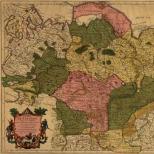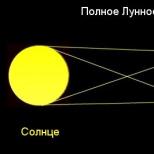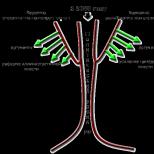Map of the Kirov railway. Map of the Kirov region with cities, towns, districts and routes. Heads of the temporary operation of the Murmansk railway
The Kirov region is located in the central-eastern part of European Russia. The map of the Kirov region shows that the region borders on the Nizhny Novgorod, Arkhangelsk, Kostroma and Vologda regions, the Republics of Komi, Mari El, Udmurtia and Tatarstan, as well as the Perm Territory. The area of the region is 120,374 sq. km.
The Kirov region is extremely rich in forests, peat, furs and phosphorites. The main sectors of the region's economy are metalworking, mechanical engineering, metallurgy, pulp-and-paper and woodworking industries.
The region is divided into 39 municipal districts, 273 villages, 53 urban settlements and 6 urban districts. Largest cities Kirov region - Kirov (administrative center), Kirovo-Chepetsk, Slobodskoy, Kotelnich and Vyatskiye Polyany.
Historical reference
In 1920, the territory of the modern Kirov region was part of the Vyatka province. In 1929 the territory became part of Nizhny Novgorod region, and then the Nizhny Novgorod region. In 1934, the Kirov Territory was formed, which in 1936 was transformed into the Kirov Region.

must visit
On detailed map Kirov region from a satellite you can see a number of cities in which the main attractions of the region are located: Kirov, Slobodskoy and Kotelnich.
It is recommended to visit the Church of Seraphim of Sarov, Assumption Trifonov Monastery and the Alexander Garden in Kirov; Catherine's Cathedral, Nikolskaya Church, the bell tower of the Church of the Transfiguration of the Savior and the Archangel Michael Gate Chapel in Slobodskoye; Velikoretsky castle in the village of Velikoretskoye; places associated with the artist Vasnetsov in the village of Ryabovo, as well as pareiasaurs - the remains of prehistoric pangolins - in Kotelnich.
Fans of eco-tourism will be interested in the reserves "Bylina", "Bushkovsky Forest" and "Pizhemsky", the reserve "Nurgush" and national park"Atarskaya Luka", lakes Lezhninskoe and Shaitan.
Note to the tourist
Gulrypsh - holiday destination for celebrities
There is an urban-type settlement Gulrypsh on the Black Sea coast of Abkhazia, the appearance of which is closely connected with the name of the Russian philanthropist Nikolai Nikolaevich Smetsky. In 1989, due to the illness of his wife, they needed to change the climate. Case decided the case.In the northern part of the Volga federal district located in the Kirov region. In terms of the area occupied by the territory, which is 120 thousand square meters. km, this region is considered one of the most significant in the country. A satellite map of the Kirov region allows you to examine its borders in detail, settlements, rivers and transport routes.
The lands of the region are heavily swamped. Huge swamps, the most significant of which are located in the northern part of the region, occupy about 40% of all land in the region. More than 19 thousand rivers flow through the districts of the region, the largest of which is the Vyatka. Also, considering the map of the Kirov region with diagrams, you will find such water arteries as:
- Pocket;
- Cap;
- Tansy;
- Moloma;
- Cobra.
The hydrography of the region is represented by a large number of lakes and ponds. In total, there are about 5 thousand closed reservoirs in the region.
The territory of the region is limited by several subjects of the Russian Federation. If you move around the map of the Kirov region with districts, you can consider that its "neighbors" are:
- Mari El Republic;
- Kostroma region;
- Udmurtia;
- Komi;
- Vologda Region;
- Tatarstan;
- Nizhny Novgorod Region.
About 1,370,000 people live in the region. The vast majority of people (76%) live in cities. The largest settlement and regional center is Kirov.
Districts of the Kirov region on the map
The region is divided into 39 districts. All areas on the map of the Kirov region can be examined in detail, sights can be found, and an idea of industrial zones and roads connecting cities and villages can be obtained. Of all the districts, Verkhnekamsky occupies the largest territory. It is located in the northeast of the region, so it is always colder in this area than in others.
The smallest is the Vyatsko-Polyansky district, but it is home to the largest number of people. It is divided into two parts by the Vyatka River. The map of the Kirov region with settlements makes it possible to see the city of Vyatskiye Polyany on the right bank of the Vyatka, in which industrial enterprises, universities, a museum and various attractions are located. The left-bank part of the district is mainly involved in agriculture.
A part of the Trans-Siberian Railway, as well as the Kirov-Kotlas highway, passes through the districts of the region. On a detailed road map of the Kirov region, you can find the main routes, see how to get to the cities of the region, and also build a route for driving to neighboring regions. Using the online service, you can also consider the railway tracks that pass through all areas, except for Kumensky and Slobodsky.
Map of the Kirov region with cities and villages
If you look at the map of the Kirov region with villages and cities, you will notice that there are few large settlements in the region. industrial and cultural centers are Kirovo-Chepetsk and Kirov.
But even small settlements have many attractions, which tourists from other regions often come to visit. If you came here for the first time, then use the map of the Kirov region with villages, which will help you find interesting places you want to visit:
- N. Pochinok - the Church of St. Nicholas the Wonderworker;
- With. Veloretskoye - an ancient temple;
- Kotelnich - Nurgush Reserve.
In the villages and villages, ancient buildings have been preserved, which are recognized as architectural monuments. Those who are interested in the history of the region and art should visit Kirov. The city has attractions such as:
- arboretum;
- Museum of M. Saltykov-Shchedrin;
- Paleontological Museum.
The map of the Kirov region will show in detail how to drive or get to any object. It is convenient to use it in any travel, pilgrimage trips or business trips.
Economy and industry of the Kirov region
The main contribution to the economy of the Kirov region is made by industrial enterprises. In the cities of the region there are factories of various industries. The following industries are developed in the region:
- chemical;
- metallurgical;
- light;
- food.
Use Yandex maps of the Kirov region to find plants and factories that produce products for the aviation industry, fertilizers, plastic products, car tires, plywood. Light industry enterprises are famous for fur and leather products.
Peat is mined from minerals here. And the main wealth of the region is coniferous forests, which occupy more than half of the entire territory of the region.
Agriculture is represented by plant growing and animal husbandry. The main crops grown in the region:
- rye;
- potato;
- forage crops.
Great importance in the region is given to the development of tourism. There are about 200 nature reserves and 3 resort areas here. Many vacationers, eco-tourists and fishermen gather on the lakes in the summer season.
The starting point of the Ilek narrow-gauge railway was the village of Chus, located near the right bank of the Kama River. The starting point of the Perervinskaya narrow-gauge railway was the village of Kurya (on topographic maps it is most often indicated as Kama), located near the right bank of the Kama River, about 50 kilometers north of Chus. For a long time, narrow-gauge railways operated as a single network.
According to information from P. Kashin, the first section of the narrow gauge railway near the village of Kurya (Kamsky) was built in 1949. narrow gauge Railway belonged to the Perervinsky timber industry enterprise. Initially, it bore the official name "Skachkovskaya narrow-gauge railway", which came from the village of Skachok, neighboring Kurya. In 1960, another name was given - the Perervinskaya narrow-gauge railway.
The Ilek narrow-gauge railway (the starting point is the village of Chus) was founded in a close period of time. The owner of this narrow-gauge railway was the Kaisky timber industry enterprise.
Around 1960, the Ilekskaya and Perervinskaya narrow-gauge railways were connected. It became possible to travel by rail from Chus to Kurya, which improved living conditions in the remote village of Kurya, which did not have a road connection (there was a road in Chus at that time). A passenger train ran regularly on the route Chus - Kurya.
On the Perervinskaya narrow-gauge railway, there was a forest settlement Zhekan (evicted in 1975) and a significant number of shift forest camps, in which "lifters" lived - purveyors of resin (pine resin). Harvesting resin, along with logging, was widespread in this area.
According to P. Kashin, approximately in 1975, the Ilek narrow-gauge railway, which runs from the village of Chus in an easterly direction, was dismantled. Since that time, only the Perervinskaya narrow-gauge railway operated (from the village of Kurya to the south). The length of the highway was 22 kilometers, the rest was dismantled.
In the 1980s, the lumber station in Kurya was gradually transferred to truck haulage. After 1985, the regular removal of timber by narrow-gauge railway was discontinued, since that time it has been carried out only during the thaw period, when the movement of timber trucks became problematic. In 1990, the last section of the narrow gauge railway was dismantled. One of the diesel locomotives TU6A was transported to the Khristoforovskaya narrow-gauge railway.
In August 2007, railway researchers P. Kashin and S. Kostygov visited Chus and Kurya. According to information from P. Kashin, the cab of the MD54-4 motor locomotive, lying on the banks of the Kama, was preserved in Kurya. In Chus, no rolling stock of the narrow-gauge railway has been preserved.
The Ozhmegovskaya narrow-gauge railway was a timber-carrying, “floating” one, owned by the Kaisky timber industry enterprise. According to reports former Ministry timber industry, the first section of the narrow gauge railway was opened in 1952.
The length of the lines of the narrow gauge railway at the peak of its development was at least 70 kilometers. There were several shift camps on the lines of the narrow-gauge railway (Knyazevka, Dalniy Kym and others). The settlements were intended for the temporary residence of workers-throwers (producers of turpentine).
The narrow gauge railway was completely dismantled. Estimated liquidation period - 1970s.
__________________________________________________________________________________________________
This narrow-gauge railway was logging, was run by a correctional labor institution. The starting point of the narrow gauge railway, the village of Sosnovka I, was connected by a broad gauge branch to the Razdelnaya Gayno-Kai railway station.
The length of the narrow-gauge railway, according to topographic maps, was about 30 kilometers.
The narrow gauge railway was completely dismantled. Estimated liquidation period - the beginning of the 1990s. Later, the village of Sosnovka I was liquidated, the broad gauge branch leading to it was dismantled.
__________________________________________________________________________________________________
__________________________________________________________________________________________________
As of 2008, a narrow gauge railway is in operation.
__________________________________________________________________________________________________
A narrow gauge railway on a 1:100,000 topographic map published in 1962.
A narrow gauge railway on a 1:200,000 topographic map published in 1986.The Verkhnekamsk phosphorite mine has been the main enterprise of the Verkhnekamsky district of the Kirov region for a long time. The mine produces phosphorite ore by open pit mining.
According to information from railway researcher P. Kashin, a narrow-gauge railway at the Verkhnekamsk phosphorite mine was opened in 1915 - long before the broad gauge railway appeared in this area. Presumably, at that time it led to a pier on the banks of the Kama River, from which phosphorite ore was transported by water.
In the 1930s, a broad gauge railway line was opened from the Yar station to the phosphorite mine. Since that time, the products of the mine began to be transported by rail. Near the village of Rudnichny, a multi-level intersection of broad and narrow gauge railway lines was built.
The narrow-gauge railway reached its highest development in the early 1980s. At that time, its length was at least 40 kilometers.
In the 1980s, a decision was made to reconstruct the narrow gauge railway to a standard gauge of 1520 mm. According to information from P. Kashin, the work on reconstruction to broad gauge was completed in 1987. Almost all diesel locomotives operating on the narrow gauge railway were cut or transferred to other narrow gauge railways.
As of 2003 (information from P. Kashin), the Verkhnekamsky phosphorite mine practically did not work. On the broad gauge railway line owned by the mine, there was one narrow gauge diesel locomotive adapted for operation on broad gauge tracks - TU7-1336, and a significant number of broad gauge diesel locomotives (TGM4, TGM40 and others).
As of May 2008, the Verkhnekamsk phosphorite mine was almost non-operational. The broad gauge railway line belonging to the mine, leading to the quarries located to the south-west of the Rudnichny settlement, was not in operation, but was not dismantled.
__________________________________________________________________________________________________
Narrow-gauge railway in the vicinity of the village of Brusnichny. The starting point is the village of Brusnichny (it has not existed since the 1970s).
Narrow gauge railway on a topographic map at a scale of 1:100,000,
published in 1962 (eastern part), 1967 (western part).
Marked only in the eastern part.
The only source of information about this narrow gauge railway is a 1:100,000 topographic map published in 1962. The narrow-gauge railway was a logging railway. The length of the narrow gauge railway, according to the map, was about 8 kilometers.
The narrow gauge railway was completely dismantled. Approximate liquidation period: 1960s.
__________________________________________________________________________________________________
Loevskaya (?) narrow-gauge railway. The starting point is the village of Loevka (does not exist since the 1970s).
A narrow gauge railway on a 1:100,000 topographic map published in 1967.
Area where the narrow-gauge railway is located on a topographic map
scale 1:200,000, published in 1986.The only source of information about this narrow gauge railway is a 1:100,000 topographic map published in 1967. The narrow-gauge railway was a logging, "rafting" one. The length of the narrow gauge railway, according to the map, was about 20 kilometers.
The narrow gauge railway was completely dismantled. Approximate liquidation period: 1970s. Simultaneously with the narrow-gauge railway, the village of Loevka was liquidated.
The building in Petrozavodsk, where the Office was located Kirov railway.
In 1959 it was included in the structure Oktyabrskaya railway with city administration Leningrad as the Order of the Red Banner of Labor Murmansk Branch of the Order of Lenin of the October Railway.
Control
Control Murmansk railway formed in 1917. Was in the city Petrozavodsk. In January 1918, a board was formed to manage the road, consisting of representatives from the Olonets, Murmansk and Petrograd Soviets and three delegates from the Main Road Committee. In March 1918, the executive committee council of railway deputies. In 1919, the road administration was transferred to the city Petrograd. In 1922 the Board was organized Murmansk railway. On May 1, 1930, the Board was liquidated and the Directorate was organized Murmansk railway.
Kirov railway had control.
On May 22, 1940, by order of the People's Commissariat for Communications, from July 1, 1940, the city of Kirov was determined as the location of the Kirov Railway Administration. Petrozavodsk.
Control Kirov railway consisted of:
- secretariat
- planning department
- accounting department
- financial department
- forest department
- automotive department
- military department
- personnel department
- department of educational institutions
- supply management
Control Kirov railway was in charge services :
- buildings and structures
- movements
- passenger
- signaling and communications
- electrification
- fuel economy
- wagon
- medical and sanitary
- logistics
- road inspector.
Railway had a number press organs published in Petrozavodsk - the newspapers "Murmansky Put" ("Way") (1917), "Krasny Sever" (an organ of the Executive Committee of the Council of Deputies of the Murmansk Railway) (1918), "Polar Highway" (1933-1936), "Kirovskaya highway" (1936-1959), also had their own newspapers political departments branches in Petrozavodsk - "Transportnik" (organ of workers and employees of the 2nd district of the Murmansk railway) (1930-1935), "Semaphore" (organ of the party committee and MK of the Petrozavodsk station traffic service (1934), "Puteets" (organ of the party trade union organization 3rd distance) (1934), Kandalaksha - “Polar whistle” (organ of the political department and regional trade union of the 4th branch of the Murmansk railway) (1931-1935), “Shpala” (organ of the party organization and MK of the 8th distance of the track) (1934 ), "Shock Electric Highway" (organ party committee and the academic committee of the 1st section of the electrification of Kandalaksha of the Kirov Railway (1935) and Kemi - "Kemsky Transport" (organ of collectives VKP(b) And local committees station Kem) (1934), the road took part in the release of the socio-economic journal "Bulletin of the Murmansk Railway" ("Bulletin of Murman", "Bulletin of the Karelian-Murmansk Territory", "Karelo-Murmansk Territory") (1923-1935) . In 1922-1926. in Petrograd (Leningrad) the "Bulletin of the Murmansk Railway" ("Bulletin of the Murmansk Railway Administration") was published.
Story
After approval on January 1, 1915 Emperor Nicholas II construction of railways from Petrozavodsk to Soroka Bay and further to the Murmansk coast at the expense of the treasury, a department was created for the construction of railway lines Petrozavodsk - Sorotskaya Bay and Murmansk under the general supervision of engineer V.V. Goryachkovsky. On the section of the road Petrozavodsk-Soroka construction work engineer V. L. Lebedev was in charge, in the Soroka-Murman section - engineer P. E. Solovyov.
The official Act of Acceptance for Temporary Operation of the Murmansk Railway was signed on November 15, 1916. In 1917, the construction department was liquidated, the department of the Murmansk railway was formed, headed by the head of the road.
From April 1, 1917 to Murmansk railway attached, bought by the state, private Olonets railway(line Zvanka station - Petrozavodsk station).
Temporary commodity traffic is open from January 1, 1917, from April 1, 1917 Murmansk railway included in direct communication with Russian railways.
On September 15, 1917, regular passenger traffic began, along the entire section of the road from Zvanka to Murmansk, a passenger train No. 3/4 passed.
In 1917, the number of permanent workers and employees of the Murmansk railway was about 16.5 thousand people.
In 1919, a part of the road (in the Kemsky and Aleksandrovsky districts of the Arkhangelsk province) was controlled by the Provisional Government of the Northern Region and subordinated to the head of the region's communications in the city of Arkhangelsk.
January 20th 1919 a to Murmansk railway plot attached Tikhvin - Rybatskoe northern railway .
On December 19, 1936, an electrified section was put into operation Kandalaksha - Apatity.
In February-April 1940, the Petrozavodsk line was built - Suoyarvi.
The most violent and systematic attacks on facilities Kirov railway were made in December and in the first half of the city. The enemy was especially active aviation on the section of the road from the station Kandalaksha to the station Louhi 164 km long. In this direction, the enemy had aerodrome from which to Kirov railway it was only 75 km, i.e. 10 minutes flight.
Over the Kirov Railway, I. G. Inozemtsev, Winged Defenders of the North.
July 13, 1959 by resolution Council of Ministers of the USSR No. 748 "On the strengthening of railways" and the order of the Ministry of Railways of the USSR No. 42 of July 14, 1959 Kirov railway And Oktyabrskaya railway were merged into the Oktyabrskaya railway with management in the city of Leningrad.
List of some road leaders (years)
Heads of the Department for the Construction of the Murmansk Railway
- Vladimir Vasilyevich Goryachkovsky (1914-1917)
Head of works on the construction of the Murmansk railway
Heads of the temporary operation of the Murmansk railway
- Anatoly Vladimirovich Skopichenko (1917)
Commissars, chief commissioners of the road and chairmen of the executive committee of the commissariat for the management of the Murmansk railway
Chairman of the Board of the Murmansk Railway and the Murmansk Combine
Heads of the Murmansk (Kirov) railway
see also
Notes
- The management of the Murmansk railway moves to Petrograd. The representative office of the road remains in Petrozavodsk // Izvestiya of the executive committee of the Olonets Council of Peasants', Workers' and Red Army Deputies. December 6, 1918
- Nikolsky I. M. Nature, population, economy, history and culture of Karelia // Bibliographic index. Issue 1. Petrozavodsk: Petrozavodsky Publishing House state university, 2008. P.36-37












